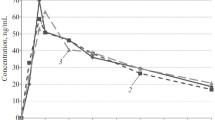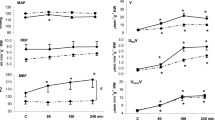Summary
In a double blind, cross over study the haemodynamic effects of an i.v. infusion of adrenaline during concomitant administration of atenolol, pindolol, propranolol or placebo were examined in 7 healthy volunteers.
During coadministration with placebo, adrenaline caused an increase in systolic blood pressure (SBP) of 26 mm Hg and a decrease in diastolic blood pressure (DBP) of 20 mm Hg. Heart rate (HR) and stroke volume (SV) were increased by about 20–30%. Total peripheral resistance (TPR) fell significantly. When the subjects were pretreated with atenolol, the adrenaline increased SBP by 16 mm Hg, the DBP did not change, HR and SV increased by 19 and 30%, and TPR fell.
During concomitant administration of the non-selective betablocker pindolol, which has strong intrinsic sympathomimetic activity (ISA), adrenaline increased SBP by 11 mm Hg and DBP by 17 mm Hg. This pure pressor response led to a significant reduction in HR and SV and an increase in TPR, probably mediated through the baroreceptors. The haemodynamic response to adrenaline during coadministration of propranolol was very similar to that seen after pindolol. It is concluded that a beta1-selective blocker interferes very little with the haemodynamic response to adrenaline, whereas it is changed to a pure pressor response during coadministration of a non-selective betablockers. ISA did not significantly modify the pressor response.
Similar content being viewed by others
References
Johnsson G (1975) Influence of metoprolol and propranolol on haemodynamic effects induced by adrenalin and physical work. Acta Pharmacol Toxicol 36 [Suppl V]: 59–68
van Herwaarden CLA, Fennis JFM, Binkhorst RA, van't Laar A (1977) Haemodynamic effects of adrenaline during treatment of hypertensive patients with propranolol and metoprolol. Eur J Clin Pharmacol 12: 397–402
Hjemdahl P, Åkerstedt T, Pollare T, Gillberg M (1983) Influence of beta-adrenoceptor blockade by metoprolol and propranolol on plasma concentrations and effects of noradrenaline and adrenaline during i.v. infusion. Acta Physiol Scand 515 [Suppl]: 45–53
Houben H, Thien T, van't Laar A (1982) Effect of lowdose epinephrine infusion on haemodynamics after selective and nonselective beta-blockade in hypertension. Clin Pharmacol Ther 31: 685–690
Raptis S, Rosenthal J, Welzel D, Moulopoulos S (1981) Effects of cardioselective and non-cardioselective betablockade on adrenaline-induced metabolic and cardiovascular responses in Man. Eur J Clin Pharmacol 20: 17–22
Kubicek WG, Karnegis JN, Patterson RP, Witsoe DA, Mattson RH (1966) Development and evaluation of an impedance cardiac output system. Aerospace Med 37: 1208–1214
Smith JJ, Bush JE, Wiedmeier VT, Tristani FE (1970) Application of impedance cardiography to study of postural stress. J Appl Physiol 29: 133–138
Denniston JD, Maher JF, Reeves JT, Cruz JC, Cymerman A, Grover RF (1976) Measurement of cardiac output by electrical impedance at rest and during exercise. J Appl Physiol 40: 91–96
Hallböök T, Månsson B, Nielsen RA (1970) A strain-gauge plethysmograph with electrical calibration. Scand J Clin Lab 25: 413–418
Svendsen TL, Hartling OJ, Trap-Jensen J, McNair A, Bliddal J (1981) Adrenergic beta-receptor blockade: Haemodynamic importance of intrinsic sympathomimetic activity at rest. Clin Pharmacol Ther 29: 711–718
Clark BJ, Menninger K, Bertholet A (1982) Pindolol — The pharmacology of a partial agonist. Br J Clin Pharmacol 13: 149s-158s
McMurtry RJ (1974) Propranolol, hyperglycemia and hypertensive crisis. Ann Intern Med 80: 669–670
Schlüter KJ, Aellig WH, Petersen KG, Riebund HC, Wehrli A, Kerp L (1982) The influence of beta-adrenoceptor blocking drugs with and without intrinsic sympathomimetic on the hormonal responses to hypo- and hyperglycaemia. Br J Clin Pharmacol 13: 407s-17s
Trap-Jensen J, Carlsen JE, Hartling O, Svendsen TL, Tangø M, Christensen NJ (1982) Beta-adrenoceptor blockade and psychic stress in man. A comparison of the acute effects of labetalol, metoprolol, pindolol and propranolol on plasma levels of adrenaline and noradrenaline. Br J Clin Pharmacol 13: 391s-96s
Author information
Authors and Affiliations
Rights and permissions
About this article
Cite this article
Rehling, M., Svendsen, T.L., Maltbæk, N. et al. Haemodynamic effects of atenolol, pindolol and propranolol during adrenaline infusion in man. Eur J Clin Pharmacol 30, 659–663 (1986). https://doi.org/10.1007/BF00608212
Received:
Accepted:
Issue Date:
DOI: https://doi.org/10.1007/BF00608212




